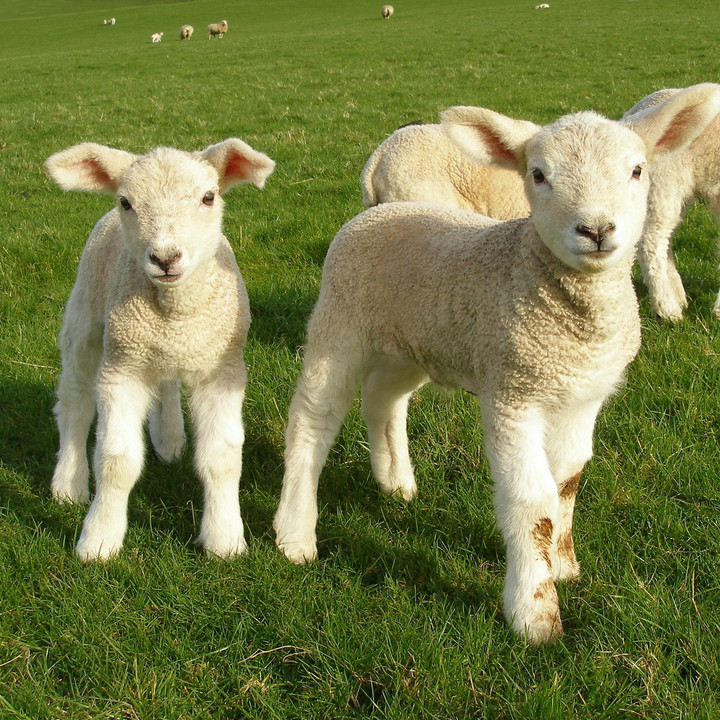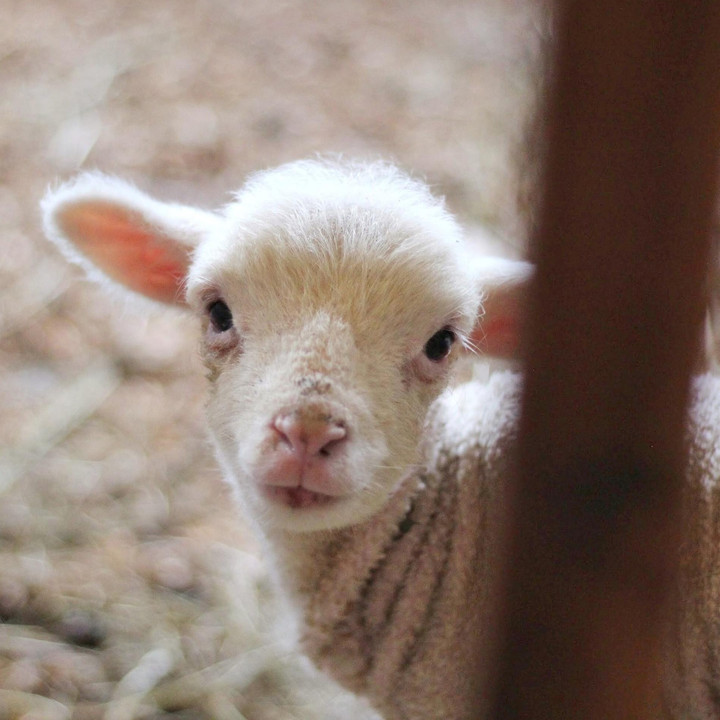
7 Crucial Questions About Live Lamb Cutting (Mulesing) And Pain Relief
Shedding light on the silent suffering of live lamb cut sheep, and why lamb cutting with pain relief is far from the best long-term solution to dealing with flystrike
Around 70 million sheep are shorn for their wool in Australia each year1. The local wool industry is worth billions, with around 345 million kilos produced annually, which go on to be worn by shoppers1. But the truth behind wool production is not always as cosy as you might think. So, what questions do we need to be asking and what do we need to know?
What is live lamb cutting (mulesing) and why does it happen?
Australian Merino sheep have been selectively bred over decades to grow more and finer wool, through developing excess skin to provide more surface area for wool growth. However, these excess skin folds, known as 'wrinkles', become a hotspot for blowflies. The folds retain moisture, creating a damp environment, especially around the hindquarter where urine and faeces accumulate — creating a perfect breeding ground for blowfly eggs and maggots.2
This issue can result in a painful condition known as ‘flystrike’. If left untreated, flystrike can be lethal for the sheep. Unfortunately, the widely practiced solution in Australia — lamb cutting— falls far short of the welfare standards upheld by other wool-producing countries that have banned this archaic and barbaric procedure.
So, what exactly is live lamb cutting (mulesing)? Lamb cutting involves restraining lambs, usually between 6 and 10 weeks old, on their backs on a metal cradle. This immobilisation prevents them from escaping while sharp shears, akin to garden shears, are used to cut away large sections of their skin and flesh around their tails.
The result is the growth of wool free scar tissue, which doesn’t attract flies (so long as it heals properly). Despite industry rhetoric, this is done without sufficient pain management3, subjecting the lambs to excruciating stress and suffering4.
How many lambs suffer – aren’t most of them receiving ‘pain relief’?
Over 10 million lambs undergo live lamb cutting annually, subjecting them to acute pain that persists for days, while the healing process takes weeks6. Despite claims that 75% of live lamb cut lambs receive what the industry likes to promote as ‘pain relief’7, a closer look reveals that most are treated with a topical solution, Tri-Solfen, applied post-mutilation. In essence, lambs endure the full extent of the procedure without adequate pain management8.
A 2022 wool producer survey disclosed that less than one out of ten farmers surveyed are administering a local anaesthetic in conjunction with an analgesic during live lamb cutting (mulesing), which is the best available combination of pain relief5. Even with this available ‘best practice’ approach, there is next to no pain relief during the procedure and only partial relief after the procedure, given that all the pain relief is even applied properly in the first place.
Recent investigative footage shared by Collective Fashion Justice in 2022 and 2023 exposes the distressing reality behind mulesing, even with pain relief.
Viewer discretion is advised: The footage contains distressing content that may be difficult to watch.
The survey, furthermore, pointed out that there is confusion about the different available pain relief products, leaving room for ineffective applications and more pain. Wool Producers Australia, a key representative body of Australian sheep farmers pride themselves for having a ‘progressive policy’ aligning with the newest animal welfare science the ‘Five Domains model’ while supporting lamb cutting (mulesing) with mandatory pain relief9. However, a true understanding of the latest animal welfare science, the Five Domains model, would call for an urgent shift away from lamb cutting (mulesing), not just some form of inadequate pain management becoming mandatory10.
While some growers will be using pain relief meaningfully, suggesting that its use alongside lamb cutting (mulesing) should remain in the future of the wool industry and without defining a clear end date to the practice, is simply a ploy to retain its social licence.
But doesn't live lamb cutting (mulesing) protect sheep against flystrike?
Say goodbye to live lamb cutting (mulesing) – there are better options available! Live lamb cutting (mulesing) does not even effectively prevent flystrike on other areas of a sheep's body, known as 'bodystrike'8.
Embracing flystrike-resistant sheep breeding and management offers a pain-free alternative that has been tried and tested by the industry for over two decades. This approach focuses on breeding healthier and more resilient sheep while maintaining the desired wool quality and quantity.
With over 4,000 successful cases of transitioning away from live lamb cutting (mulesing) in Australia, the time has come for wool growers to transition especially as brands are increasingly making commitments to end their use of live lamb cut sheep wool. Jock Laurie, Chairman of the Australian Wool Innovation, recently pointed out that brands might be exploring other wool exporters because of live lamb cutting (mulesing).11
Is live lamb cutting (mulesing) carried out by veterinary professionals while being strictly regulated?
Not really. While pain relief is mandatory in only two Australian states (Victoria and Tasmania), live lamb cutting (mulesing) is carried out by farmers or contractors, to keep the process cheap, easy and convenient. If the same procedure was carried out on a companion animal such as a dog or cat in a veterinary clinic, the treatment would substantially change, including full anaesthesia and many more steps to ensure the animals' wellbeing. The public would likely protest such a procedure, and the veterinarian probably lose their licence.
So, do we just need to make pain relief mandatory?
As we have seen, even when administering pain relief, this invasive procedure causes intense pain and stress for the young lambs12. While immediate and adequate pain relief, based on a combination of analgesia and anaesthetic should be mandatory during a planned transition phase, pain relief for live lamb cutting (mulesing) is not enough to protect lambs from excruciating suffering8 and trauma8. Pain-free alternatives, which are more effective in protecting the whole sheep’s body, are available and tested by the industry.
What are the alternatives and who is leading the way?
The pain-free alternative is the transition to more flystrike-resistant sheep breeds – known as ‘smooth’ or ‘plain’ bodies, instead of ‘wrinkly’ sheep. According to wool growers who have transitioned and stopped live lamb cutting (mulesing), the change generally takes around 3-5 years. Therefore, FOUR PAWS alongside other animal protection organisations, will never be satisfied with the continuation of live lamb cutting (mulesing) even with some form of pain management, and are calling for the industry to end the practice. During the interim period, every effort should be taken to minimise suffering, as we work towards eradicating live lamb cutting (mulesing) completely.
Not convinced yet? Our Wear it Kind team was able to recently visit woolgrowers on the ground in New South Wales who have transitioned to flystrike resistant breeding. These farmers shared insights, revealing that overbred Merino sheep can carry up to 15 kg of excess skin, a considerable burden. According to their experiences switching to flystrike-resistant breeding not only alleviates this weight but also brings several benefits to the growers, including higher survival rates for lambs and ewes, improved birthing success, enhanced bonding between newborn lambs and mothers, and more efficient feed conversion for a positive environmental impact. Explore our grower case studies for more details1, 2.
What can you do?
Sign our petition to protect lambs from live lamb cutting (mulesing), and check out the brands that have signed our Brand Letter of Intent – committing to and calling for an end to the practice.
If you are a professional and want your brand to be a voice for compassion, sign our open brand letter today and be part of the movement.
Source
2. Greeff JC, Schlink AC, Karlsson LJE, Vercoe PE, Gilmour AR. Importance of humidity and temperature in breech strike of Merino sheep. Animal Production Science. 2022;63(5):480–488. doi:10.1071/AN21579
3. Colvin AF, Reeve I, Kahn LP, Thompson LJ, Horton BJ, Walkden-Brown SW. Australian surveys on incidence and control of blowfly strike in sheep between 2003 and 2019 reveal increased use of breeding for resistance, treatment with preventative chemicals and pain relief around mulesing. Veterinary Parasitology: Regional Studies and Reports. 2022;31:100725. doi:10.1016/j.vprsr.2022.100725
4. Hemsworth PH, Barnett JL, Karlen GM, Fisher AD, Butler KL, Arnold NA. Effects of mulesing and alternative procedures to mulesing on the behaviour and physiology of lambs. Applied Animal Behaviour Science. 2009;117(1):20–27. doi:10.1016/j.applanim.2008.12.007
5. Promising lab results help Australia’s sheep industry edge closer to flystrike vaccine - ABC News. [accessed 2023 Nov 14]. https://www.abc.net.au/news/rural/2023-05-05/promising-results-sheep-flystrike-vaccine-australia/102305012
https://www.abc.net.au/news/rural/2023-05-05/promising-results-sheep-flystrike-vaccine-australia/102305012
6. Lee C, Fisher AD. Welfare consequences of mulesing of sheep. Australian Veterinary Journal. 2007;85(3):89–93. doi:10.1111/j.1751-0813.2007.00114.x
7. Managing flystrike and mulesing in sheep - CSIRO. [accessed 2023 Nov 14]. https://www.csiro.au/en/research/animals/livestock/managing-flystrike-and-mulesing-in-sheep
8. Fisher AD. Addressing pain caused by mulesing in sheep. Applied Animal Behaviour Science. 2011;135(3):232–240.
9. Policy | Wool Producers Australia. WoolProducers Aust. [accessed 2023 Nov 22]. https://www.woolproducers.com.au/policy
10. Mellor DJ, Beausoleil NJ, Littlewood KE, McLean AN, McGreevy PD, Jones B, Wilkins C. The 2020 Five Domains Model: Including Human–Animal Interactions in Assessments of Animal Welfare. Animals. 2020;10(10):1870. doi:10.3390/ani10101870
11. Sim T. Does AWI’s position on non-mulesed wool match demand? Sheep Central. 2023 [accessed 2023 Nov 22]. https://www.sheepcentral.com/does-awis-position-on-non-mulesed-wool-match-demand/
12. Paull D, Lee C, Atkinson S, Fisher A. Effects of meloxicam or tolfenamic acid administration on the pain and stress responses of Merino lambs to mulesing. Australian Veterinary Journal. 2008;86(8):303–311. doi:10.1111/j.1751-0813.2008.00325.x
13. Grandin T. Livestock handling and transport. 3rd edition. Wallingford: CABI; 2007.



